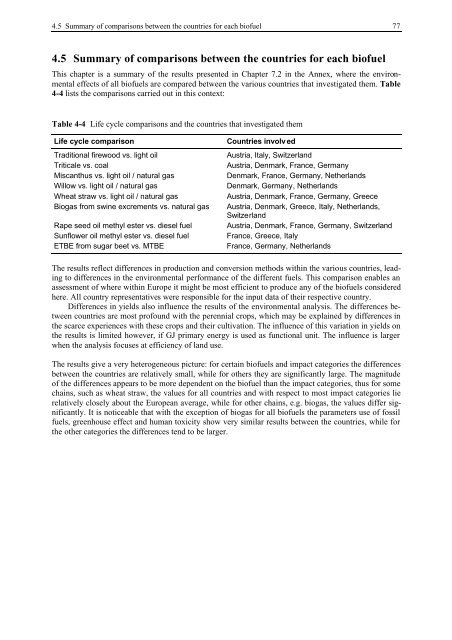BIOENERGY FOR EUROPE: WHICH ONES FIT BEST?
BIOENERGY FOR EUROPE: WHICH ONES FIT BEST?
BIOENERGY FOR EUROPE: WHICH ONES FIT BEST?
Create successful ePaper yourself
Turn your PDF publications into a flip-book with our unique Google optimized e-Paper software.
4.5 Summary of comparisons between the countries for each biofuel 77<br />
4.5 Summary of comparisons between the countries for each biofuel<br />
This chapter is a summary of the results presented in Chapter 7.2 in the Annex, where the environmental<br />
effects of all biofuels are compared between the various countries that investigated them. Table<br />
4-4 lists the comparisons carried out in this context:<br />
Table 4-4 Life cycle comparisons and the countries that investigated them<br />
Life cycle comparison Countries involved<br />
Traditional firewood vs. light oil Austria, Italy, Switzerland<br />
Triticale vs. coal Austria, Denmark, France, Germany<br />
Miscanthus vs. light oil / natural gas Denmark, France, Germany, Netherlands<br />
Willow vs. light oil / natural gas Denmark, Germany, Netherlands<br />
Wheat straw vs. light oil / natural gas Austria, Denmark, France, Germany, Greece<br />
Biogas from swine excrements vs. natural gas Austria, Denmark, Greece, Italy, Netherlands,<br />
Switzerland<br />
Rape seed oil methyl ester vs. diesel fuel Austria, Denmark, France, Germany, Switzerland<br />
Sunflower oil methyl ester vs. diesel fuel France, Greece, Italy<br />
ETBE from sugar beet vs. MTBE France, Germany, Netherlands<br />
The results reflect differences in production and conversion methods within the various countries, leading<br />
to differences in the environmental performance of the different fuels. This comparison enables an<br />
assessment of where within Europe it might be most efficient to produce any of the biofuels considered<br />
here. All country representatives were responsible for the input data of their respective country.<br />
Differences in yields also influence the results of the environmental analysis. The differences between<br />
countries are most profound with the perennial crops, which may be explained by differences in<br />
the scarce experiences with these crops and their cultivation. The influence of this variation in yields on<br />
the results is limited however, if GJ primary energy is used as functional unit. The influence is larger<br />
when the analysis focuses at efficiency of land use.<br />
The results give a very heterogeneous picture: for certain biofuels and impact categories the differences<br />
between the countries are relatively small, while for others they are significantly large. The magnitude<br />
of the differences appears to be more dependent on the biofuel than the impact categories, thus for some<br />
chains, such as wheat straw, the values for all countries and with respect to most impact categories lie<br />
relatively closely about the European average, while for other chains, e.g. biogas, the values differ significantly.<br />
It is noticeable that with the exception of biogas for all biofuels the parameters use of fossil<br />
fuels, greenhouse effect and human toxicity show very similar results between the countries, while for<br />
the other categories the differences tend to be larger.

















